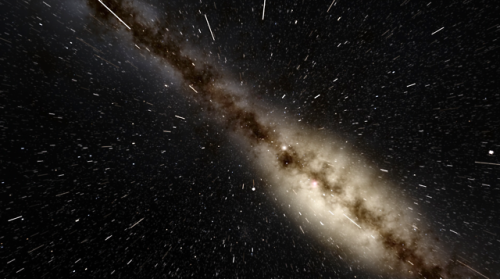The Tails Of Comet NEOWISE!! Comet’s Usually Have 2 Tails That Always Point Away From The Sun.

The tails of Comet NEOWISE!! Comet’s usually have 2 tails that always point away from the Sun.
Here, NEOWISE’s blue ion tail on the left points directly away from the Sun and is pushed out by the flowing and charged solar wind. Structure in the ion tail comes from different rates of expelled blue-glowing ions from the comet's nucleus, as well as the always changing structure of our Sun's wind.
The other tail, the dust tail, is pushed out by sunlight, but curves towards its orbital path as heavier dust particles are better able to resist this light pressure. Comet NEOWISE's (Comet C/2020 F3) impressive dust-tail striations are not fully understood, as yet, but likely related to rotating streams of sun-reflecting grit liberated by melting ice on its 5-kilometer wide nucleus. Image Credit & Copyright: Zixuan Lin (Beijing Normal U.)
More Posts from Nyxs-knight and Others
hello….. i’m a bit nervous because i’ve never really interacted with radfems as a dysphoric person before but i would just like to reach out for some help, if at all possible. to the dysphoric/detransitioned radfems: what are some things that helped you cope with your dysphoria? i’ve been really starting to question wether or not transitioning is something i want to do, and i’m trying to consider ways of dealing with dysphoria through other means before going down that path. anything at all helps, thank you.

*heavy metal guitars wailing* Find this illustration in my shop as an art print, sticker, tees, and more! Visit the shop link in my main profile.


hey it’s me we’ve got hat hair and a dirty mirror but we also have PROGRESS 💪

This unusual planetary nebula, NGC 7027, is one of the smallest, brightest, and most unusually shaped planetary nebulas known. Given its expansion rate, NGC 7027 first started expanding, as visible from Earth, about 600 years ago. For much of its history, the planetary nebula has been expelling shells, as seen in blue in the featured image.
In modern times, though, for reasons unknown, it began ejecting gas and dust (seen in red) in specific directions that created a new pattern that seems to have four corners. What lies at the nebula's center is unknown, with one hypothesis holding it to be a close binary star system where one star sheds gas onto an erratic disk orbiting the other star. NGC 7027, about 3,000 light years away, was first discovered in 1878 and can be seen with a standard backyard telescope toward the constellation of the Swan (Cygnus).
Image Credit: NASA, ESA, Joel Kastner (RIT) et al.; Processing: Alyssa Pagan (STScI)
-
 spooooooooooooooooky liked this · 1 year ago
spooooooooooooooooky liked this · 1 year ago -
 brutalistnortheast liked this · 2 years ago
brutalistnortheast liked this · 2 years ago -
 rodrigocantarino reblogged this · 2 years ago
rodrigocantarino reblogged this · 2 years ago -
 rodrigocantarino liked this · 2 years ago
rodrigocantarino liked this · 2 years ago -
 psikonauti liked this · 2 years ago
psikonauti liked this · 2 years ago -
 ydeserves reblogged this · 2 years ago
ydeserves reblogged this · 2 years ago -
 usummonedme liked this · 2 years ago
usummonedme liked this · 2 years ago -
 cmi1972 liked this · 3 years ago
cmi1972 liked this · 3 years ago -
 kihani reblogged this · 3 years ago
kihani reblogged this · 3 years ago -
 keeponmovingss liked this · 3 years ago
keeponmovingss liked this · 3 years ago -
 chisaharu-chiha reblogged this · 3 years ago
chisaharu-chiha reblogged this · 3 years ago -
 chisaharu-chiha liked this · 3 years ago
chisaharu-chiha liked this · 3 years ago -
 shesapunkbaby reblogged this · 3 years ago
shesapunkbaby reblogged this · 3 years ago -
 shesapunkbaby liked this · 3 years ago
shesapunkbaby liked this · 3 years ago -
 romero74 liked this · 3 years ago
romero74 liked this · 3 years ago -
 comeoffage reblogged this · 3 years ago
comeoffage reblogged this · 3 years ago -
 keeponmovingss reblogged this · 3 years ago
keeponmovingss reblogged this · 3 years ago -
 richwall101 liked this · 3 years ago
richwall101 liked this · 3 years ago -
 diddislilmonster reblogged this · 3 years ago
diddislilmonster reblogged this · 3 years ago -
 deep-spacediver577 liked this · 3 years ago
deep-spacediver577 liked this · 3 years ago -
 barristergeek reblogged this · 4 years ago
barristergeek reblogged this · 4 years ago -
 rebld reblogged this · 4 years ago
rebld reblogged this · 4 years ago -
 rebld liked this · 4 years ago
rebld liked this · 4 years ago -
 g1rumble liked this · 4 years ago
g1rumble liked this · 4 years ago -
 thewolfandhismoon liked this · 4 years ago
thewolfandhismoon liked this · 4 years ago -
 youareartmydear liked this · 4 years ago
youareartmydear liked this · 4 years ago -
 viktumless reblogged this · 4 years ago
viktumless reblogged this · 4 years ago -
 exploring2000 liked this · 4 years ago
exploring2000 liked this · 4 years ago -
 xdsirius reblogged this · 4 years ago
xdsirius reblogged this · 4 years ago -
 xdsirius liked this · 4 years ago
xdsirius liked this · 4 years ago








